民航服务英语
- 格式:ppt
- 大小:2.31 MB
- 文档页数:11
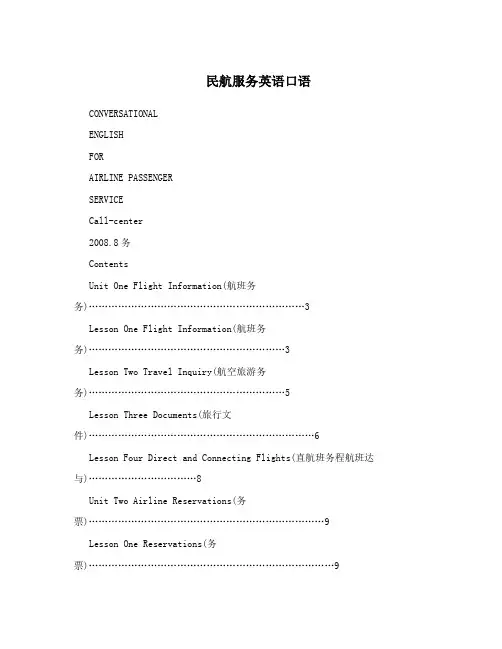
民航服务英语口语CONVERSATIONALENGLISHFORAIRLINE PASSENGERSERVICECall-center2008.8务ContentsUnit One Flight Information(航班务务) (3)Lesson One Flight Information(航班务务) (3)Lesson Two Travel Inquiry(航空旅游务务) (5)Lesson Three Documents(旅行文件) (6)Lesson Four Direct and Connecting Flights(直航班务程航班达与) (8)Unit Two Airline Reservations(务票) (9)Lesson One Reservations(务票) (9)Lesson Two Onward Reservations(务务程票) (10)Lesson Three Reservation Change(务票改务) (12)Lesson Four Delay and Cancellation(延务取消与) (13)Lesson Five Standby(候务) (14)Unit Three Ticketing and Fares(出票票价与) (16)Lesson One Ticketing(出票) (16)Lesson Two Fares and Means of Payments(票价支付方式与) (17)Lesson Three Lost Ticket and Refund(机票务失退票与) (18)Unit Four Reconfirmation(再务务) (19)Unit Five Check In(务理登机手务) (20)Lesson One Normal Check-in(务理登机手务) (20)Lesson Two Ticket and Passport(机票务照与) (22)Lesson Three Seat Preference and Baggage(座位务务行李与) (23)Lesson Four At the Check-in Counter(在行李交台运柜) (24)Unit Six At the Information Counter(在务务务) (25)Lesson One Passenger List(旅客务务) (25)Lesson Two At the Information Counter(在务务务) (26)Unit Seven Arrivals(到达) (28)Lesson One Transit Passengers(务境旅客) (28)Lesson Two Baggage Handling(行李务理) (29)Unit Eight Hotel and Ground Transportation(旅务地面交通与) (30)Lesson One Hotel(旅务) (30)Lesson Two Ground Transportation(地面交通) (31)Unit Nine A Charter Flight(包机) (33)Unit One Flight InformationLesson OneFlight InformationNotes1.How are you doing? 你好务,务是一句务候务。
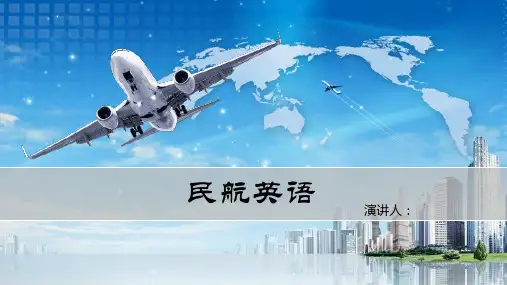
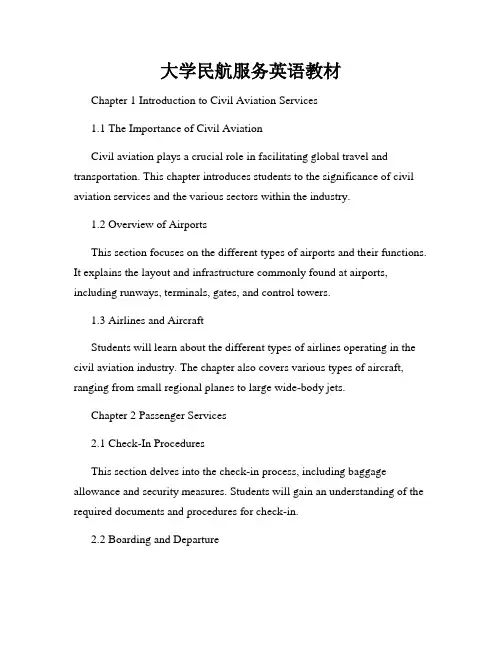
大学民航服务英语教材Chapter 1 Introduction to Civil Aviation Services1.1 The Importance of Civil AviationCivil aviation plays a crucial role in facilitating global travel and transportation. This chapter introduces students to the significance of civil aviation services and the various sectors within the industry.1.2 Overview of AirportsThis section focuses on the different types of airports and their functions. It explains the layout and infrastructure commonly found at airports, including runways, terminals, gates, and control towers.1.3 Airlines and AircraftStudents will learn about the different types of airlines operating in the civil aviation industry. The chapter also covers various types of aircraft, ranging from small regional planes to large wide-body jets.Chapter 2 Passenger Services2.1 Check-In ProceduresThis section delves into the check-in process, including baggage allowance and security measures. Students will gain an understanding of the required documents and procedures for check-in.2.2 Boarding and DepartureStudents will learn about boarding procedures, including gate assignments, boarding passes, and pre-flight safety checks. This section also explains how airlines handle boarding and departure delays.2.3 In-Flight ServicesThis section explores the range of services available to passengers during a flight, such as onboard meals, entertainment systems, and in-flight shopping. Students will understand the importance of providing excellent customer service during the flight.Chapter 3 Safety and Security3.1 Aviation Security MeasuresStudents will learn about the various security measures implemented to ensure the safety of passengers and crew. This section covers topics such as baggage screening, passenger screening procedures, and the role of air marshals.3.2 Emergency ProceduresThis section outlines the emergency procedures to be followed in the event of a crisis, such as an aircraft evacuation or medical emergencies. Students will understand the importance of proper training and preparedness for handling such situations.Chapter 4 Airline Operations4.1 Airline Reservations and TicketingStudents will gain insight into the process of making airline reservations, issuing tickets, and managing seat availability. This section also covers ticket pricing and fare structures.4.2 Baggage Handling and TrackingThis section explores the procedures involved in handling and tracking passenger baggage. Students will learn about the importance of accurate baggage handling and the use of advanced tracking technologies.4.3 Airline Customer ServiceStudents will understand the role of customer service in the civil aviation industry. This section focuses on handling customer inquiries, complaints, and providing assistance to passengers with special needs.Chapter 5 Airline Management5.1 Airline Finance and EconomicsThis section provides an overview of the financial aspects of running an airline, including revenue management, cost control, and profitability analysis. Students will gain insights into the economic challenges faced by airlines.5.2 Crew Resource ManagementStudents will learn about the importance of effective crew resource management in ensuring operational safety. This section covers topics such as crew communication, decision-making processes, and teamwork.5.3 Airline Marketing and PromotionThis section introduces students to the basics of airline marketing and promotion. It explores strategies used to attract and retain passengers, including advertising campaigns and loyalty programs.ConclusionThe completion of this English textbook on university-level civil aviation services equips students with essential knowledge about the industry. With an understanding of the various aspects of civil aviation, students will be prepared for future careers in this field.。
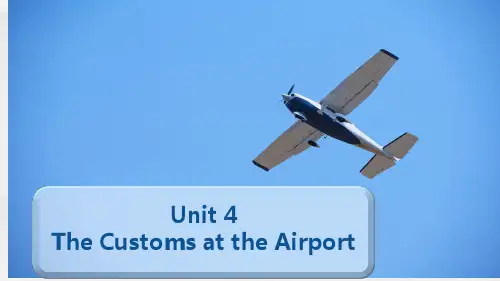
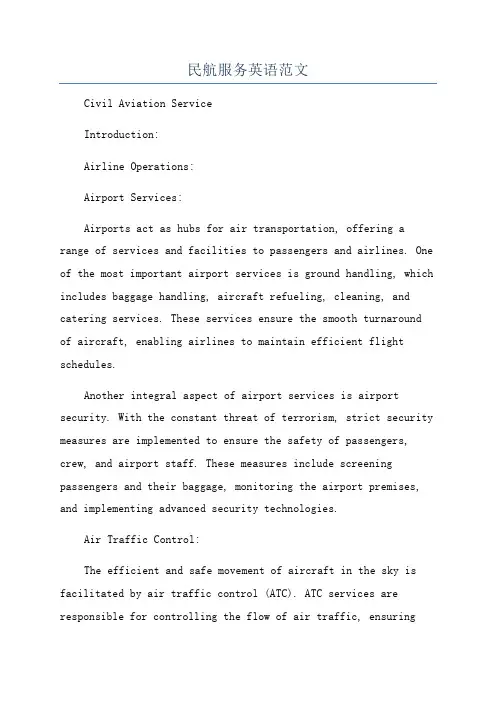
民航服务英语范文Civil Aviation ServiceIntroduction:Airline Operations:Airport Services:Airports act as hubs for air transportation, offering a range of services and facilities to passengers and airlines. One of the most important airport services is ground handling, which includes baggage handling, aircraft refueling, cleaning, and catering services. These services ensure the smooth turnaround of aircraft, enabling airlines to maintain efficient flight schedules.Another integral aspect of airport services is airport security. With the constant threat of terrorism, strict security measures are implemented to ensure the safety of passengers, crew, and airport staff. These measures include screening passengers and their baggage, monitoring the airport premises, and implementing advanced security technologies.Air Traffic Control:The efficient and safe movement of aircraft in the sky is facilitated by air traffic control (ATC). ATC services are responsible for controlling the flow of air traffic, ensuringsafe separation between aircraft, and providing guidance to pilots during takeoff, landing, and flight. These services are crucial in preventing mid-air collisions and maintaining the overall safety of the aviation industry.Aircraft Maintenance:Importance of Civil Aviation Service:Civil Aviation Service plays a pivotal role in facilitating economic growth, trade, and tourism. It connects people and businesses across the globe, enabling them to reach their destinations quickly and efficiently. Moreover, it promotes cultural exchange and fosters international cooperation.The aviation industry also creates employment opportunities, both directly and indirectly. Airlines, airports, and aircraft manufacturers employ a vast workforce, contributing to economic development and prosperity. Additionally, civil aviation service supports various other sectors such as tourism, hospitality, and retail, further boosting economic growth.Conclusion:。
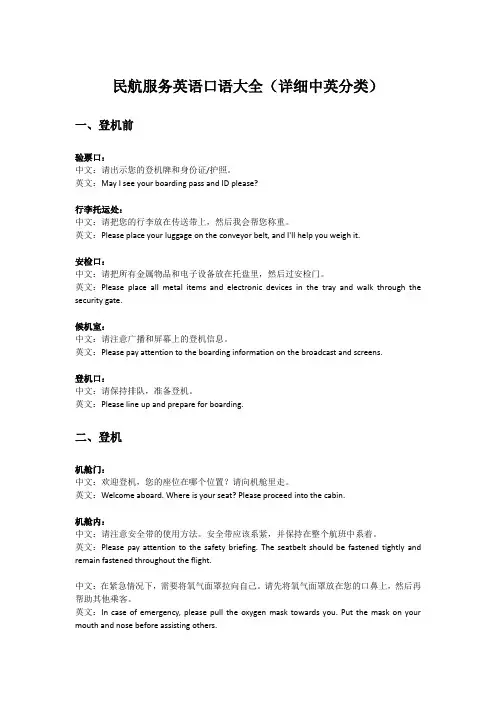
民航服务英语口语大全(详细中英分类)一、登机前验票口:中文:请出示您的登机牌和身份证/护照。
英文:May I see your boarding pass and ID please?行李托运处:中文:请把您的行李放在传送带上,然后我会帮您称重。
英文:Please place your luggage on the conveyor belt, and I'll help you weigh it.安检口:中文:请把所有金属物品和电子设备放在托盘里,然后过安检门。
英文:Please place all metal items and electronic devices in the tray and walk through the security gate.候机室:中文:请注意广播和屏幕上的登机信息。
英文:Please pay attention to the boarding information on the broadcast and screens.登机口:中文:请保持排队,准备登机。
英文:Please line up and prepare for boarding.二、登机机舱门:中文:欢迎登机,您的座位在哪个位置?请向机舱里走。
英文:Welcome aboard. Where is your seat? Please proceed into the cabin.机舱内:中文:请注意安全带的使用方法。
安全带应该系紧,并保持在整个航班中系着。
英文:Please pay attention to the safety briefing. The seatbelt should be fastened tightly and remain fastened throughout the flight.中文:在紧急情况下,需要将氧气面罩拉向自己。
请先将氧气面罩放在您的口鼻上,然后再帮助其他乘客。
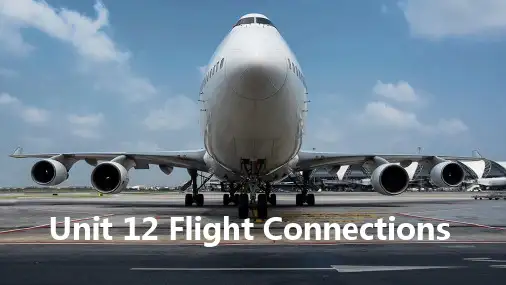
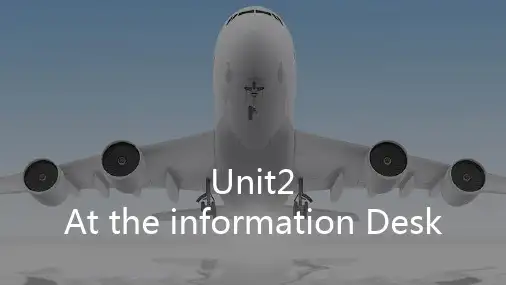
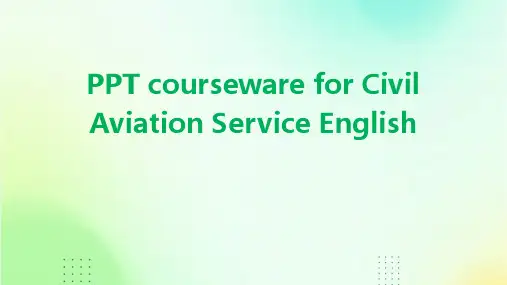
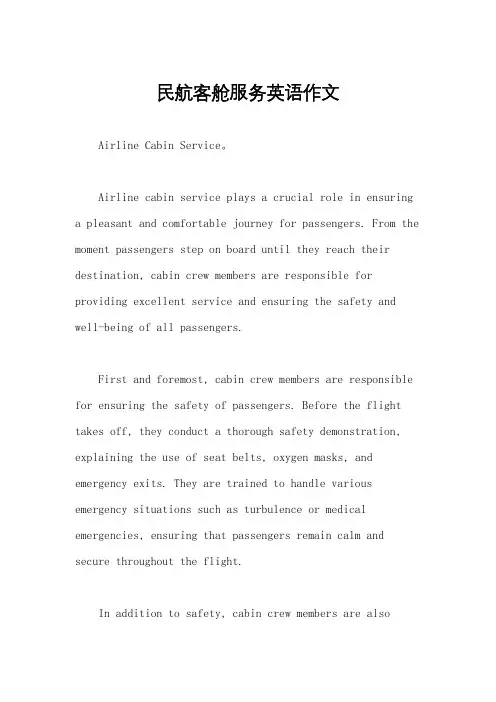
民航客舱服务英语作文Airline Cabin Service。
Airline cabin service plays a crucial role in ensuring a pleasant and comfortable journey for passengers. From the moment passengers step on board until they reach their destination, cabin crew members are responsible for providing excellent service and ensuring the safety and well-being of all passengers.First and foremost, cabin crew members are responsible for ensuring the safety of passengers. Before the flight takes off, they conduct a thorough safety demonstration, explaining the use of seat belts, oxygen masks, and emergency exits. They are trained to handle various emergency situations such as turbulence or medical emergencies, ensuring that passengers remain calm and secure throughout the flight.In addition to safety, cabin crew members are alsoresponsible for providing exceptional customer service. They greet passengers with a warm smile and assist them in finding their seats and storing their luggage. They are trained to handle various passenger requests, such as dietary restrictions, special assistance, or language barriers. They strive to make each passenger feel comfortable and attended to throughout the flight.During the flight, cabin crew members serve meals and beverages to passengers. They ensure that all passengers receive their preferred choices and accommodate special dietary requirements. They are attentive to passengers' needs, constantly checking if they require any additional assistance or amenities. Whether it's providing extra blankets, pillows, or entertainment options, cabin crew members go above and beyond to make passengers feel at ease and satisfied.Moreover, cabin crew members are responsible for maintaining a clean and tidy cabin environment. They ensure that lavatories are regularly cleaned and stocked with necessary supplies. They also monitor the cabin temperatureand lighting, ensuring that it is comfortable for all passengers. They are trained to handle any spills or messes promptly, ensuring that the cabin remains presentable throughout the flight.Lastly, cabin crew members play a vital role in resolving any conflicts or issues that may arise during the flight. They are trained in conflict resolution and communication skills, ensuring that any disputes or concerns are addressed promptly and efficiently. Theystrive to create a harmonious and peaceful environment for all passengers, ensuring a pleasant journey for everyone on board.In conclusion, airline cabin service is essential for providing passengers with a safe, comfortable, and enjoyable journey. Cabin crew members are responsible for ensuring the safety and well-being of passengers, providing exceptional customer service, maintaining a clean environment, and resolving any conflicts or issues that may arise. Their dedication and professionalism contribute to a positive travel experience for all passengers.。
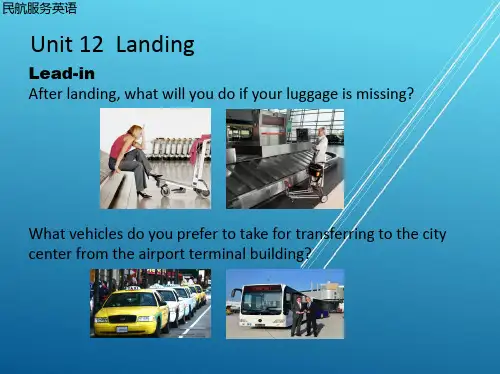
民航客舱服务英语作文范文Title: Elevating Passenger Experience: A Comprehensive Guide to Civil Aviation Cabin Services。
Introduction。
Civil aviation cabin services play a pivotal role in ensuring a comfortable and seamless travel experience for passengers. From boarding to disembarkation, every aspect of cabin service contributes to passenger satisfaction and loyalty. In this essay, we will explore the key elements of cabin services and discuss strategies to enhance theoverall passenger experience.Pre-flight Preparation。
Before passengers even step foot on the aircraft, cabin crew meticulously prepare the cabin to ensure a welcoming environment. This involves cleaning and sanitizing the cabin, arranging seats according to passenger preferences,and conducting safety checks. Additionally, cabin crew members greet passengers with warm smiles and assist them with stowing carry-on luggage, setting a positive tone for the journey ahead.In-flight Services。
民航服务英语口语民航服务英语口语CONVERSATIONALENGLISHFORAIRLINE PASSENGERSERVICECall-center2008.8务ContentsUnit One Flight Information(航班务务) (3)Lesson One Flight Information(航班务务) (3)Lesson Two Travel Inquiry(航空旅游务务) (5)Lesson Three Documents(旅行文件) (6)Lesson Four Direct and Connecting Flights(直航班务程航班达与) (8)Unit Two Airline Reservations(务票) (9)Lesson One Reservations(务票) (9)Lesson Two Onward Reservations(务务程票) (10)Lesson Three Reservation Change(务票改务) (12)Lesson Four Delay and Cancellation(延务取消与) (13)Lesson Five Standby(候务) (14)Unit Three Ticketing and Fares(出票票价与) (16)Lesson One Ticketing(出票) (16)Lesson Two Fares and Means of Payments(票价支付方式与) (17)Lesson Three Lost Ticket and Refund(机票务失退票与) (18)Unit Four Reconfirmation(再务务) (19)Unit Five Check In(务理登机手务) (20)Lesson One Normal Check-in(务理登机手务) (20)Lesson Two Ticket and Passport(机票务照与) (22)Lesson Three Seat Preference and Baggage(座位务务行李与) (23)Lesson Four At the Check-in Counter(在行李交台运柜) (24)Unit Six At the Information Counter(在务务务) (25)Lesson One Passenger List(旅客务务) (25)Lesson Two At the Information Counter(在务务务) (26)Unit Seven Arrivals(到达) (28)Lesson One Transit Passengers(务境旅客) (28)Lesson Two Baggage Handling(行李务理) (29)Unit Eight Hotel and Ground Transportation(旅务地面交通与) (30)Lesson One Hotel(旅务) (30)Lesson Two Ground Transportation(地面交通) (31)Unit Nine A Charter Flight(包机) (33)Unit One Flight InformationLesson OneFlight InformationNotes1.How are you doing? 你好务,务是一句务候务。